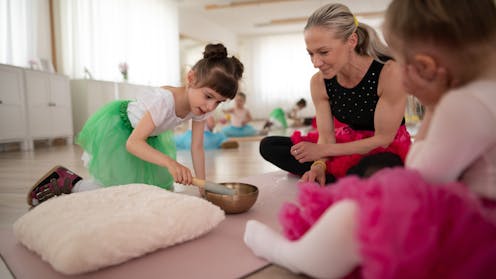Dance therapy, also known as dance movement therapy, is a form of expressive therapy that uses movement and dance to support intellectual, emotional, and motor functions of the body. It is based on the belief that the mind and body are interconnected, and that movement can be used as a tool to promote emotional, social, cognitive, and physical integration. Dance therapy is practiced in a variety of settings, including hospitals, mental health facilities, schools, and community centers. It is often used as a complementary treatment alongside traditional forms of therapy, such as talk therapy or medication. The practice of dance therapy is rooted in the idea that movement and expression can be powerful tools for healing and self-discovery.
Dance therapy is facilitated by trained professionals who are skilled in both dance and psychology. These therapists work with individuals or groups to explore and address a wide range of emotional, physical, and social issues. Through movement and dance, clients are encouraged to express themselves, release tension, and develop a greater sense of self-awareness. Dance therapy can be tailored to meet the specific needs of each individual, making it a versatile and adaptable form of therapy. Whether it’s through improvisational movement, choreographed dance routines, or guided relaxation exercises, dance therapy offers a unique and creative approach to healing and personal growth.
The Physical and Emotional Benefits of Dance Therapy
The physical benefits of dance therapy are numerous and well-documented. Regular physical activity has been shown to improve cardiovascular health, increase muscle strength and flexibility, and reduce the risk of chronic diseases such as diabetes and obesity. Dance therapy provides a fun and engaging way to incorporate movement into one’s daily routine, making it an enjoyable form of exercise for people of all ages and abilities. In addition to the physical benefits, dance therapy also offers a range of emotional benefits. Movement and dance have been shown to reduce stress, anxiety, and depression, while also promoting feelings of joy, empowerment, and self-confidence. The act of dancing can be a powerful form of self-expression, allowing individuals to connect with their emotions and release pent-up feelings in a safe and supportive environment.
One of the key emotional benefits of dance therapy is its ability to foster a sense of connection and community. Through group dance sessions, individuals have the opportunity to interact with others in a nonverbal and nonjudgmental way. This can be particularly beneficial for people who struggle with social anxiety or have difficulty expressing themselves verbally. Dance therapy can also help individuals develop greater body awareness and self-acceptance. By learning to move in new ways and explore different forms of expression, clients can develop a greater sense of confidence and self-esteem. Overall, the physical and emotional benefits of dance therapy make it a valuable tool for promoting overall health and well-being.
How Dance Therapy Can Help Manage Chronic Conditions
Dance therapy has been shown to be particularly effective in helping individuals manage chronic conditions such as arthritis, Parkinson’s disease, and fibromyalgia. The physical activity involved in dance therapy can help improve joint mobility, reduce pain, and increase overall physical function for people with arthritis. For individuals with Parkinson’s disease, dance therapy has been shown to improve balance, coordination, and gait, while also reducing symptoms such as tremors and rigidity. In addition to the physical benefits, dance therapy can also provide emotional support for individuals living with chronic conditions. The social aspect of group dance sessions can help reduce feelings of isolation and provide a sense of community for those dealing with long-term health challenges.
For people with fibromyalgia, a chronic condition characterized by widespread pain and fatigue, dance therapy can offer relief from symptoms while also promoting relaxation and stress reduction. The gentle movements involved in dance therapy can help improve muscle function and reduce tension in the body, leading to decreased pain and increased comfort. Overall, dance therapy offers a holistic approach to managing chronic conditions by addressing both the physical and emotional aspects of health.
Success Stories: Personal Accounts of Improvement through Dance Therapy
Countless individuals have experienced significant improvements in their physical and emotional well-being through dance therapy. One such success story is that of Sarah, a 45-year-old woman living with rheumatoid arthritis. Sarah had struggled with chronic pain and limited mobility for years before discovering the benefits of dance therapy. Through regular dance sessions, Sarah was able to improve her joint flexibility, reduce her pain levels, and increase her overall sense of well-being. She found that the social aspect of group dance sessions provided her with a sense of community and support that she had been lacking in her life. Sarah’s experience with dance therapy has inspired her to become an advocate for its benefits, sharing her story with others who may benefit from this unique form of therapy.
Another success story comes from Michael, a 60-year-old man living with Parkinson’s disease. Michael had experienced a decline in his physical function and overall quality of life before starting dance therapy. Through regular sessions focused on rhythm and movement, Michael was able to improve his balance, coordination, and gait. He found that the act of dancing helped him feel more connected to his body and provided him with a sense of empowerment over his condition. Michael’s experience with dance therapy has motivated him to continue exploring new forms of movement and expression as a way to manage his symptoms and maintain his overall health.
Overcoming Stigma: Breaking Down Barriers to Accessing Dance Therapy
Despite its numerous benefits, dance therapy continues to face stigma and barriers to access for many individuals. One common misconception about dance therapy is that it is only for professional dancers or those with advanced physical abilities. In reality, dance therapy is accessible to people of all ages, abilities, and backgrounds. Trained therapists are skilled at adapting their approach to meet the specific needs of each individual client, making it an inclusive form of therapy for people with diverse physical abilities.
Another barrier to accessing dance therapy is the lack of awareness about its benefits within the medical community. Many healthcare providers may not be familiar with the potential benefits of dance therapy or may not know how to refer patients to qualified practitioners. As a result, individuals may miss out on the opportunity to explore this unique form of therapy as part of their overall treatment plan.
In order to overcome these barriers, it is important for advocates of dance therapy to continue raising awareness about its benefits and advocating for greater access within healthcare settings. By educating healthcare providers about the potential benefits of dance therapy for a wide range of conditions, more individuals may have the opportunity to explore this valuable form of treatment.
Incorporating Dance Therapy into a Holistic Treatment Plan
Dance therapy can be a valuable addition to a holistic treatment plan for individuals dealing with a wide range of physical and emotional challenges. By incorporating movement and expression into one’s overall wellness routine, individuals can experience greater balance and integration in their lives. For people dealing with chronic pain or mobility issues, dance therapy can provide an enjoyable form of physical activity that promotes joint flexibility and muscle strength. For individuals struggling with anxiety or depression, the act of dancing can provide a powerful outlet for self-expression and emotional release.
In addition to its standalone benefits, dance therapy can also complement other forms of treatment such as talk therapy or medication. By incorporating movement into traditional forms of therapy, individuals may experience greater engagement in their treatment process and improved outcomes overall. Dance therapy can also be used as a tool for promoting social connection and community support for individuals who may be feeling isolated or disconnected from others.
Overall, incorporating dance therapy into a holistic treatment plan offers individuals the opportunity to explore new forms of self-expression while also addressing their physical and emotional needs in a comprehensive way.
The Future of Dance Therapy: Research and Advancements in the Field
As interest in alternative forms of therapy continues to grow, the field of dance therapy is poised for continued research and advancements in the coming years. Researchers are increasingly exploring the potential benefits of dance therapy for a wide range of conditions, including chronic pain, neurological disorders, and mental health challenges. By conducting rigorous studies on the effectiveness of dance therapy, researchers hope to further validate its benefits within the medical community.
Advancements in technology are also opening up new possibilities for the practice of dance therapy. Virtual reality platforms are being used to create immersive experiences that allow individuals to engage in movement-based therapies from the comfort of their own homes. This technology has the potential to expand access to dance therapy for people who may have difficulty accessing traditional in-person sessions.
In addition to research and technological advancements, there is also growing interest in integrating dance therapy into traditional healthcare settings such as hospitals and rehabilitation centers. By offering dance therapy alongside other forms of treatment, healthcare providers have the opportunity to provide more comprehensive care for their patients.
Overall, the future of dance therapy looks promising as researchers continue to explore its potential benefits and new opportunities emerge for integrating it into traditional healthcare settings.
In conclusion, dance therapy offers a unique approach to promoting physical and emotional well-being for individuals dealing with a wide range of challenges. Through movement-based interventions, individuals have the opportunity to explore new forms of self-expression while also addressing their physical needs in a comprehensive way. As interest in alternative forms of therapy continues to grow, the field of dance therapy is poised for continued research and advancements in the coming years. By raising awareness about its benefits and advocating for greater access within healthcare settings, more individuals may have the opportunity to explore this valuable form of treatment as part of their overall wellness routine.
Find out how Torongo Therapyplus can help you with your needs. Get in touch with us at smile@torongo.life, or call us on 02 8809 9965.































